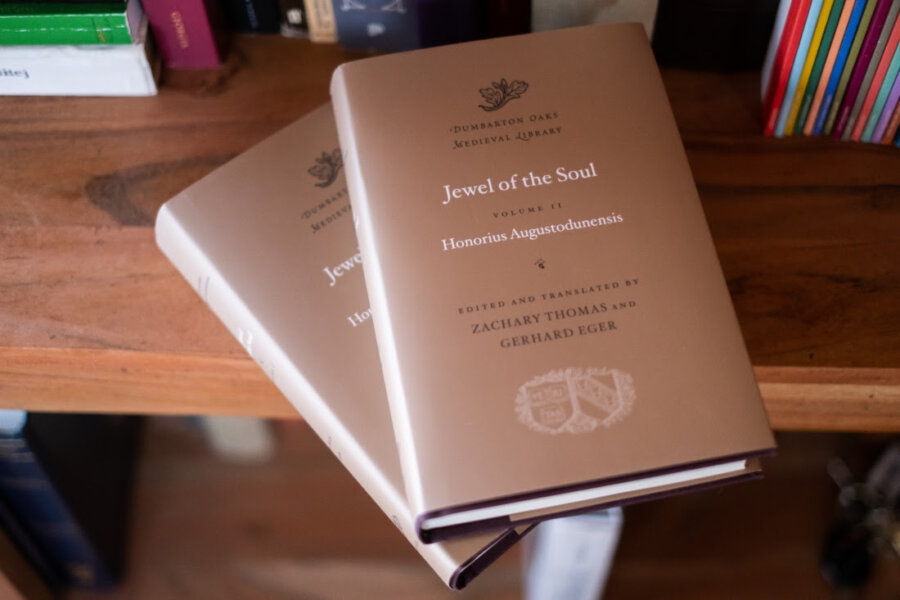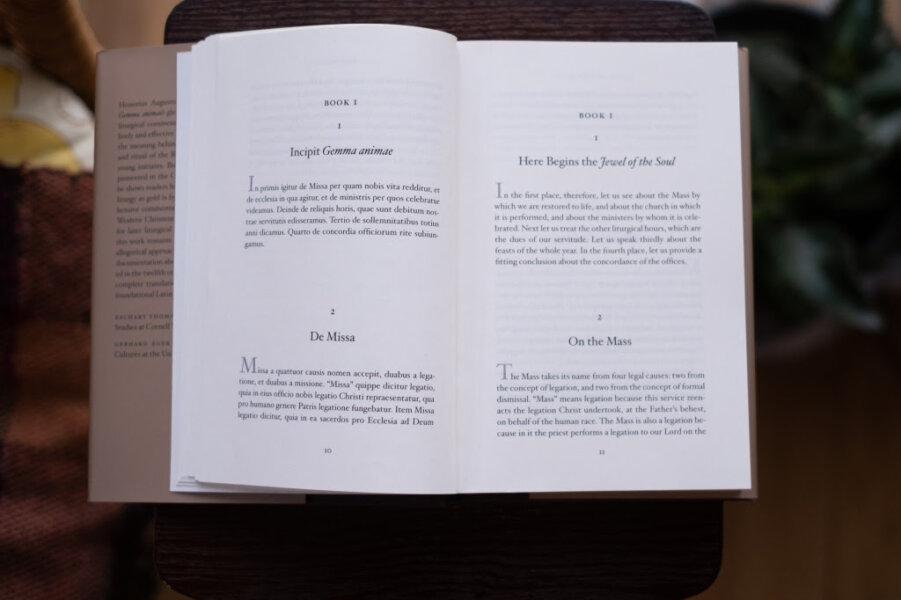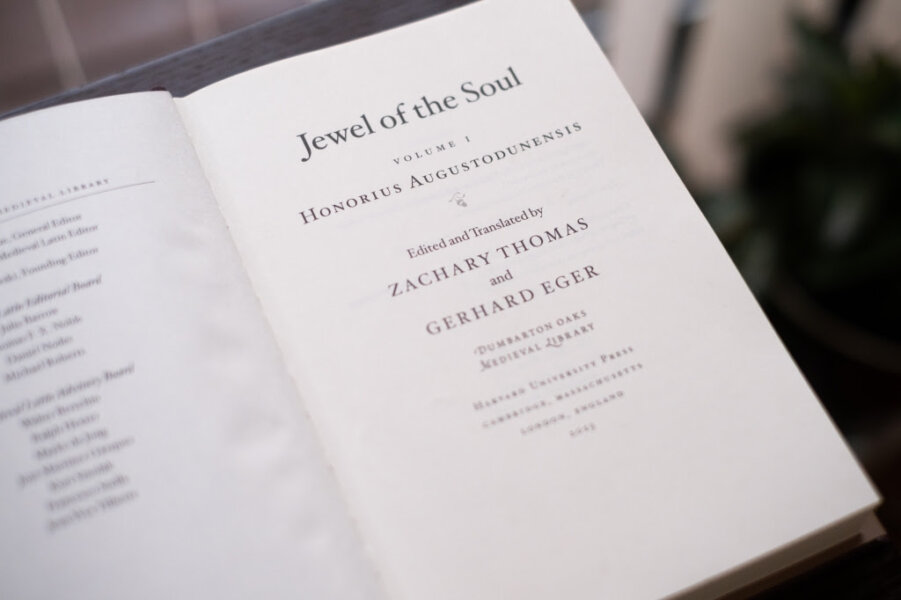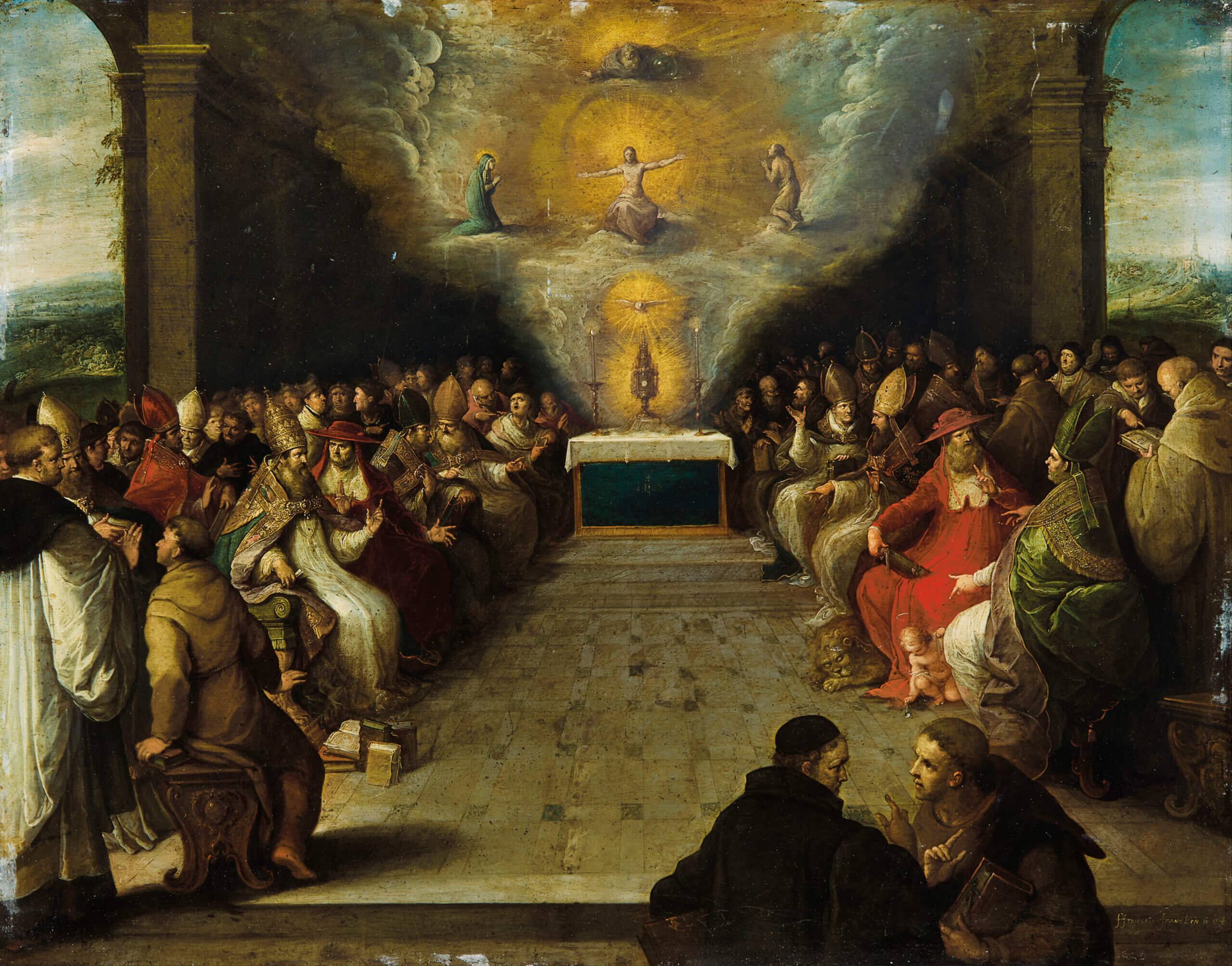Above: Disputation of the Holy Sacrament by Frans Francken the Younger (1581–1642).
For most of Christian history, the Church’s sacred rites were seen as a vast and multi-layered sacred drama, representing not only Christ’s sacrifice on the Cross, but also the whole sweep of salvation history from creation to the apocalypse. Each day in the Mass and the Office, Christ entered once more into the world, received the adoration of His subjects, renewed His saving sacrifice, and ascended into heaven, before our very eyes. Each action of the priests and ministers, as if they were actors in a play, called to mind man’s first sin in the garden, the Israelites’ battle with the Amalekites, David’s dance before the Ark, the preaching of John the Baptist, and much more. Everything that had been uttered in Scripture, everything the saints will enjoy is heaven, was wrapped up, represented, and celebrated in these mystical rites, if only one had the eyes to see it.
Unfortunately, the Latin mystagogical tradition we are describing went the way of the dodo bird in the seventeenth century, along with the spiritual exegesis of Scripture to which it has always been closely wed. Though Henri de Lubac, and more recently authors such as Carbajosa and Ratzinger, have done much to remove prejudice against this mode of reading, interest in its liturgical-mystagogical counterpart has only begun to revive. The recent publication in English of Fr. Claude Barthe’s fine introductory work is a welcome sign of this revival. Even more, I would say, is the publication of Honorius’s magnificent commentary on the liturgy, the Jewel of the Soul, in a deluxe Latin-English edition that gives us the best Latin text available and the first-ever English translation.
The Fathers of the Church and the great teachers of middle ages equipped priests and laity to use the four senses of Scripture (literal, allegorical, moral, and anagogical) to “read” the ceremonies of the Church, with the result that each word or action could convey multiple levels of edifying instruction, just like the Scriptural page. This training was conveyed both by word of mouth and by written treatises going back to the Patristic age.
Around 1120, a priest and schoolmaster known as Honorius Augustodunensis, about whose life relatively little is known, wrote a textbook for teaching this method of reading the liturgy. His Jewel of the Soul offers a concise, often charming and lively way into this tradition. For liturgical commentary, the Jewel is far more manageable than the encyclopedic work of Durandus and the genre’s more plodding pioneer Amalarius of Metz.[1]

Liturgical War and Peace
Book 1 explains the origin and symbolism of the ceremonies of the Mass, comparing it variously to the fight between David and Goliath, Moses’s battle with the Amalekites, or Christ’s “duel” with the devil. It also unveils the meaning of the sacred vessels and vestments and the spiritual significance of the church building. To give the reader a taste, here are four chapters from Book 1 that develop this analogy of the Mass to a battle. The description of the procession at a solemn Mass is just delightful!
On the Kingly and Priestly Procession (1.69)
“Moses delivering his people from Pharaoh is Christ redeeming the Christian people from the devil. They received the tables of the Law on the mountain, and we take the Gospels from the altar; the people went out under arms, and the Christian people go forth emblazoned with faith and baptism. They carried their standards before their companies, and we carry crosses and other emblems. A column of fire went before them, and candlelight goes before us. That people were splashed with blood, this one is splashed with holy water. The Levites carried the tent of meeting, and here the deacons and subdeacons carry plenaries and reliquary capsules. The ark of the covenant was carried by priests, and the shrine and feretory of relics are carried by our presbyters. The high priest Aaron follows in stately array, and among us the bishop, the high priest, follows in his pontifical vestments. If the king is present with his scepter ruling his people, he signifies Moses leading his people with his staff. If the king is not present, then the bishop expresses both: Moses by carrying his rod, and Aaron by covering his head with a miter. The sound of trumpets is imitated with the sound of bells.”
The Mass as a Battle (1.72)
“In another way, the Mass portrays the harsh battle and triumphant victory in which our enemy Amalek was laid low and a way was opened for us toward our fatherland through Jesus. For Jesus, our commander, fought with the devil and recovered for man the heavenly commonwealth that had been destroyed by his enemies. Though he might have called forth twelve legions of angels, or seventy-two thousand soldiers, he mustered the tiny band of the twelve apostles and with them subdued seventy-two kinds of tongues. The procession of the bishop, clergy, and people is like an emperor and his army marching off to battle. Their vesture—albs under copes, or other solemn vestments—make them look like war-bound soldiers who go out to battle armored with cuirasses and shields. When they leave the choir, they are like columns filing forth from the royal court. The cross and banners we carry in procession are like the ensign and standards of the imperial army. In fact, two armies go forth, since the cantors follow behind in good order. Among them are the choir masters and precentors, like the captains and sergeants who stir up the cohorts for battle. Then the officers follow as the legates and lieutenants of the army.”
Waging War by Singing against Spiritual Enemies (1.75 and 1.77)
“Battle is joined to the clash of trumpets and shouts of the throngs, and our spiritual combat begins with the clash of bells and the clergy’s singing. For our battle is waged not against enemies of blood and flesh, but against the rulers, against the authorities, against the cosmic powers of this present darkness, against the spiritual forces of evil in the heavenly places. We fight like stout soldiers when we sing with all our might from each side of the choir. Our villainous enemies cast fiery darts of concupiscence into our ranks, which the strong repel with the shield of faith. The throngs of vices press in close, but we knock them down with the sword of God’s word.”
“The reader who recites the Epistle is the herald who cries the emperor’s orders through the camp. The better voices are chosen to sing the Gradual and Alleluia, as the strongest fighters are picked for single combat. When some people falter in song, others come to their aid; so when some are sorely oppressed in battle, sturdy hearts hasten to help. Next, the cantors jubilate the Sequence with voice and organum, celebrating their victory with applause and song. The deacon who reads the Gospel from a high place is the herald after the battle who calls the dispersed army together with his trumpet. When the bishop addresses and exhorts the people, this signifies the emperor praising his victorious troops. Then when the oblations are brought up, it means that the spoils are being divided among the victorious army while the emperor looks on. The Offertory chant is the praise they offer their emperor.”
New (Old) Ways to Think about the Office
Book 2 teaches us to experience the Divine Office as a courtly ceremony where the saints of the Old Testament pay homage to Christ their King and the saints of the New toil by turns in the Lord’s vineyard. This book carries the reader impetuously along by one ingenious connection after another, demonstrating that once again—as we moderns must continually admit to our humiliation—our forefathers were far greater than we are, for they knew more about what is most important, and that enabled them to love more ardently the things we too often take for granted or even fail to notice. Here are five characteristic chapters to whet the reader’s appetite.
The Night Office as a Series of Watches (2.1)
“The night office reenacts for us the watches of heaven’s citizens. For the heavenly Jerusalem, which is built as a city, is kept secure by the angelic night watches. They share out their rounds in three vigils, dividing each into three hours, and each hour into three orders, as in thrice-three lines they sing praises to the Trinity in sweet harmony without end. It is foretold that the present Church will one day enter that city and become messmates with its citizens, and for this reason she too is called Jerusalem, and therefore she imitates the sentinels of that city in her vigils. Because this Jerusalem is only a shadow of that one, she performs this office at night, and on Sunday night, because that is when she merited to join the company of the angels. Now this city is prefigured in the basilica, where the clergy and people gather like an army for their military service. Trumpets give signals to soldiers and bells to Christians who, like mustered soldiers, salute their emperor when they begin Christ’s royal praises through the versicle Domine labia mea aperies. When they go to sleep at night, they safeguard themselves with the sign of the cross as with a seal, which they open now when they loose for God’s praise the mouths that were closed during the night. But since they keep watch in vain unless God guards the city, they invoke the divine help through the verse Deus in adiutorium meum. The cantor who begins the Invitatory is the herald who summons the sentinels to their posts. After the Venite all sing a hymn, as when soldiers muster in the camp and give honor to the king. Then they distribute the watches among themselves when they sing the three nocturns. Each watch is divided into three hours and there are three psalms in each nocturn. The angelic night guard is kept in three turns, and in our vigils three orders are marked out, namely, of psalms, readings, and responsories. There are nine readings with their responsories because the heavenly watches are celebrated by the nine orders of angels. In a similar way, the three nocturns call to mind the whole Church militant, who have campaigned in the Lord’s service during three times: before the Law, under the Law, and under grace.”
Matins Also Calls to Mind Workers in the Lord’s Vineyard (2.18)
“The night office is also an imitation of the laborers in the vineyard. When we gather at night in the church for God’s service, it is as if we are gathering in the vineyard to work. For the present life may be compared to a night sunk in the darkness of ignorance. When we begin God’s praise through Domine labia mea, we begin to work. Soon we invoke the divine aid through Deus in adiutorium meum, so that we may finish the work we have begun. Then through the Venite we exhort on our fellow laborers to carry out God’s service. Then we sing a hymn to God because we have overcome the deceits of the night. In doing so, we imitate laborers who sing while they work. Then when we sing alternately, we lay into our work with a competitive spirit. When we read the readings, we instruct ourselves how to work. When we continue on singing the responsories, we give thanks for the work we have done. For reading is mental recreation. When we read, we rest our souls made weary by the divine work, like workers in the vineyard. When we sing the responsories, we give thanks after our recreation. When we begin the psalms again, we rise refreshed to go back to work. The various nocturns are the various hours when the workmen entered the Lord’s vineyard. So that the difficulty of our labor may be made lighter, the psalms and readings show us the example of our more ancient fathers bearing the first heat and labor of the day in the vineyard.”
On the Ministers of the Night Office (2.19)
“Now the priest who begins the office stands for the paterfamilias who hires the laborers to work in the vineyard. The cantor who sings the Venite stands for the foreman who invites them to the vineyard. The hymn represents the song they sing lustily after the work is complete. The psalms teach us the works of the saints who labored in this life. The first four psalms show the morning, from Adam to Noah. The second four point to the third hour, from Noah to Abraham. The third set of four proclaims the sixth hour, from Abraham up to Moses.”
Psalms Corresponding to Patriarchs in the Vineyard (2.20)
“Now Abel was the first to begin work in the vineyard in the morning, as the first psalm Beatus vir makes plain, and he taught us to meditate on the Law of the Lord day and night, or rather to work in the vineyard, since as the Protomartyr, like a fruitful tree, he was the first to offer up the fruit of martyrdom. After him, Enos worked this vineyard, as told in the psalm Quare fremuerunt, which taught us to serve the Lord in fear in this vineyard, when the peoples of Sham raged in their wickedness and devised vain things against the Lord. Next Enoch came to tend the vineyard, as presented in the psalm Domine quid multiplicati, which teaches us to rise up from our sleep and cry to the Lord with our voice. When a multitude of evil peoples surrounded him, the Lord lifted him up. Lamech too entered into service, as we learn in the psalm Domine, ne in furore, which teaches us every night to wash our bed with tears, lest we perish along with those whom the Lord rebukes in his indignation.”
The Divine Office Compared to the Life of a Man (2.54)
“The day also enacts the life of each person, who is taught through several life stages—the various hours—to work in the Law of the Lord, as if in a vineyard. So at morning Lauds we commemorate our infancy, when we rose from night to day and were born into this world from our mothers. Justly do we praise God at this hour, rejoicing that we have been reborn in baptism from the night of error into the light of truth. At Prime we recall our childhood, the age when we began to study books. It is fitting for us to praise God at this hour, when we were being trained for his service. At Terce we recollect our adolescence, when we took orders. It is right to glorify God at this hour, when we joined the ranks of his ministers. Sext intimates our youth, when we were elevated to the diaconate or priesthood. Wherefore it is not unfitting to bless God at this hour, when we were chosen as leaders and teachers of peoples. None is our old age, when most clergy take on ecclesiastical dignities, which are as the heavier burdens of the vineyard. We magnify God, therefore, in this hour when it pleased him to place us over his people. At Vespers we recall our decrepitude, when many of us begin to live a better life, especially those of us who stood idle in the marketplace all day by living our whole lives in vanity. It is proper to render God praises at this hour, when he saw fit to join us to those who praise him. At Compline we ponder the end of our life, when we hope to be saved by confession and penance.”
Book 3 treats the feasts of the liturgical year with a special focus on the Easter mysteries. Finally, Book 4 expounds the liturgical year as a recapitulation of salvation history.

Both a Fruit of and an Incentive to “Lectio Divina”
This symbolic way of reading the liturgy has deep roots in the Apocalypse of John, and is nothing less than the monastic habit of lectio divina applied to the liturgy. Honorius is being rediscovered by modern readers who, like the clerical novices for whom this schoolmaster first wrote, are looking for an engaging, concise, and systematic introduction to medieval practices of meditation and spiritual exegesis. Through him, readers can (re)discover an entirely new way of experiencing ecclesial worship—one that is fully integrated with salvation history, eschatology, and the Christian moral life.
Timothy Troutner once posted on his Twitter page a sentiment that goes right to the heart of why a work like Jewel of the Soul is important:
One thing that really, really frustrates me about modern homilies and sermons is the loss of figural exegesis. We no longer have the ability to read our lives and the life of the Church through the lens of the lives of the patriarchs and apostles, through Israel’s history. Unlike the medievals and Church Fathers, we do not see ecclesial sin and judgment as a new Babylonian captivity, or find our trials and triumphs in the story of Joseph’s sojourn in Egypt.
Instead of framing our stories within the biblical narrative, giving our world new depth and perspective, we flatten the biblical narrative. Too often, preachers extract a “moral” from the biblical story and then apply it to our lives. The Bible can’t speak to us until it is translated into a third discourse, until its particularities, people, and images have been sucked out into lifeless principles. Instead of directly bringing the biblical world to bear on ours, the Word of God is interpreted in light of a third narrative: that of moralism. Scripture is not what gives figural depth to our lives, but is a body of texts in which we find what we already know: lessons about being nice to our neighbor or whatever.
The Scriptures cannot come to life for us until we learn how to live from within them, as if they were more real than our stories and our moralism, because they are. Or better, because their story is truly ours.
Allegorical commentary is both a fruit of and an incentive to lectio divina. If in lectio we pray and feel our way into the biblical story, becoming friends with its protagonists, mingling our hearts with theirs, in liturgy we can act out this communion with the biblical world as we continue the sacrifice of such patriarchs as Abel, Abraham, Melchisedek, and Jacob.
The co-editors of Jewel of the Soul, Zachary Thomas and Gerhard Eger, hope that this publication will help Catholics today to recover some of the riches of their prayer tradition, as well as stimulate further scholarly editing and translation of this fascinating twelfth-century author who straddled the monastic and scholastic traditions.
Honorius Augustodunensis. Jewel of the Soul [Gemma Animae]. Edited and translated by Zachary Thomas and Gerhard Eger. Volume 1: 656 pages. Volume 2: 624 pages. Cambridge, MA: Harvard University Press, 2023.
The volumes can be purchased from the usual book vendors. At Amazon: Volume 1 and Volume 2. For Dr Erik Ellis’s review at New Liturgical Movement, click here.

[1] For exegesis, another graduate of the Polis Institute, Daniel Suárez Landívar, has published a text and translation of the Expositio in Cantica canticorum, a bold new reading of the Song which is regarded as one of Honorius’s masterpieces. Other texts, such as his commentary on the Psalms and a popular sermon collection, remain unedited and untranslated. Honorius’s mind was broad; his works are a veritable library of clerical culture. For instance, he had a marked interest in cosmology and history, even wrote tracts on contemporary politics and pastoral care. Further work to bring his oeuvre to the public would do a great service for our understanding of medieval Christian culture.


